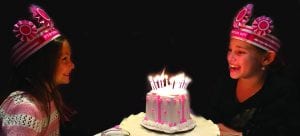Does the thought of how your children may behave this Halloween send a chill up your spine? If you answered yes, you are not alone, because millions of other parents share this concern.
“If there is any holiday that parents have mixed feelings about, it is Halloween,” said Jane Hersey, national director of the nonprofit Feingold Association (www.feingold.org), a charity that helps children with learning and behavior problems. “Parents love to help their kids dress up in Halloween costumes, but many dread they will become little monsters after eating all of that additive-filled candy.”
Sugar has often been portrayed as the villain behind the hyperactivity, temper tantrums and other bad behavior that many children display after eating Halloween candy, but recent studies have shown that the real culprits are petroleum-based food dyes, like Red 40 and Yellow 5, which are found in many of these candies.
One such study is a 2011 Australian trial conducted at the Royal Melbourne Institute of Technology, which was sponsored by the Feingold Association. This study of children ages 4 through 12 found that a diet eliminating synthetic food dyes and other additives, as well as certain foods, led to significant improvements in behavioral problems like attention deficit hyperactivity disorder (ADHD) and oppositional behavior.
More evidence of synthetic food dyes’ harmful nature was provided in a major reevaluation of previous studies on diet and ADHD, which was published in the American Journal of Psychiatry. The authors of this 2013 meta-analysis concluded that a diet eliminating these dyes appeared to have “beneficial effects on ADHD symptoms.”
According to a 2013 study on the food dye Blue 1, the negative effects of dyes in lollipops and other hard candies are exacerbated by the fact that these chemicals are not only ingested normally, but are also absorbed directly into the bloodstream through the tongue.
“We all used to laugh when children would stick out their brightly colored blue or yellow tongues after eating artificially dyed candies, but now we know that the effects of these chemicals on their behavior are not so funny,” said Hersey.
In fact, Hersey and others believe that the increasing prevalence of synthetic food dyes and other additives in foods marketed to children has contributed to the dramatic rise in childhood hyperactivity in the United States. The Centers for Disease Control and Prevention recently found that one in five high school age boys and 11 percent of children overall have been diagnosed with ADHD, which represents a 41 percent increase over the past decade.
Recognition of synthetic food dyes’ harmful effects resulted in the British Food Standards Agency advising parents to consider eliminating these additives from their children’s diet. The European Union also issued rules requiring labels on foods containing these dyes to state that the colorings “may have an adverse effect on activity and attention in children.”
In the United States, a 2011 Food and Drug Administration advisory panel narrowly rejected requiring warning labels on artificially dyed foods, but the recent accumulation of research highlighting these dyes’ effects on children’s behavior might lead the FDA to reconsider this decision.
Until the FDA takes such action, how can you protect your children from these ghoulish chemicals at Halloween? “Parents can plan for a healthier, more peaceful holiday by helping their kids avoid the worst of the candy and organizing activities that take the emphasis off sweets,” said Hersey.
She offers the following tips:
Feed Kids Before Trick or Treating. Feed your children before they go out to collect their candy. A full stomach is good insurance against their snacking on sweets as they go from door to door.
Choose Healthier Candy. Offer to trade healthier treats for the candies they collect. Parents can find a wide selection of natural candies and low-additive brand-name foods in the Feingold Association’s Foodlist & Shopping Guide.
Throw a pizza party. Plan a Halloween-themed pizza party for your children and their friends. Kids could wear their costumes to the party, which could be in your home or at their favorite pizza place.
Camp out. Camp out with your children on Halloween night. Pitch a tent in the back yard, grill some hot dogs, and tell ghost stories.
Rent a Scary Movie. Make Halloween a movie night. Let your kids pick a scary film to rent and treat them to all the popcorn they want.
Give Them Toys. Toys are a great alternative to candy. Check your local dollar store for Halloween-themed items like vampire teeth, squishy eyeballs, glow-in-the-dark insects and jumping spiders.
“Halloween does not have to be a stressful time for parents,” said Hersey. “With some planning, your children won’t act like little goblins after they have taken off their Halloween costumes!”
The nonprofit Feingold Association helps families use a low-additive diet developed by the late
Dr. Benjamin Feingold, a pediatrician who was Chief of Allergy at San Francisco’s Kaiser Permanente Medical Center. www.feingold.org • 800-321-3287





